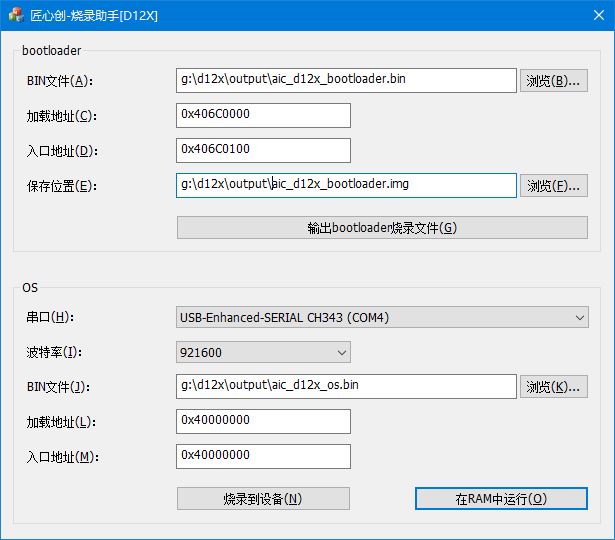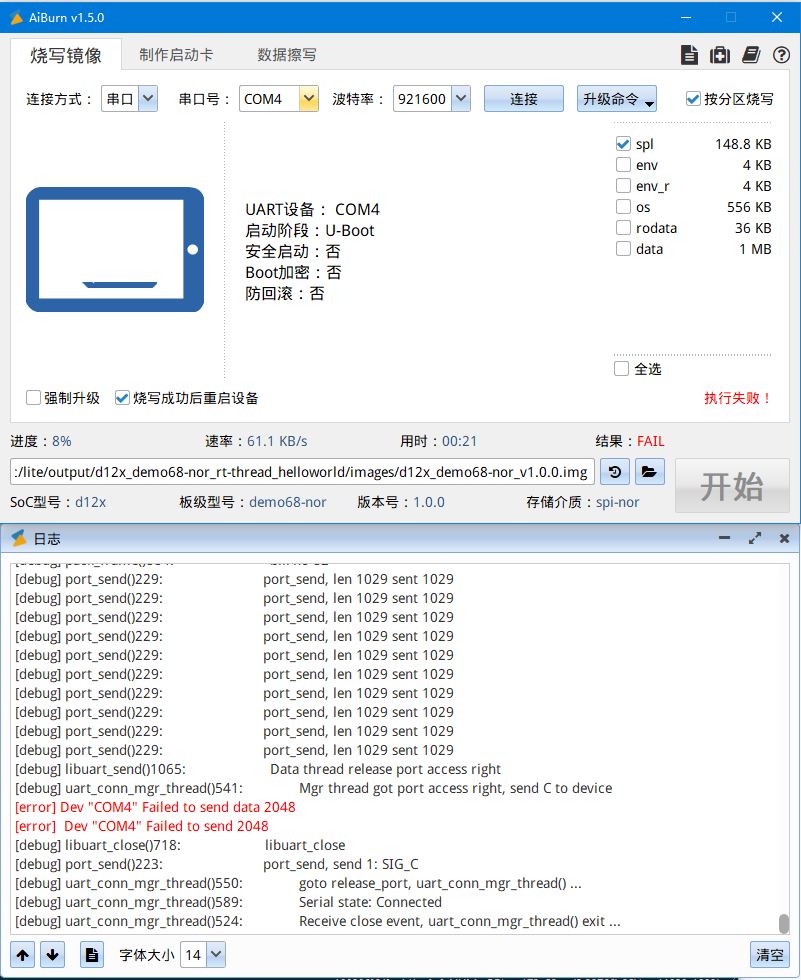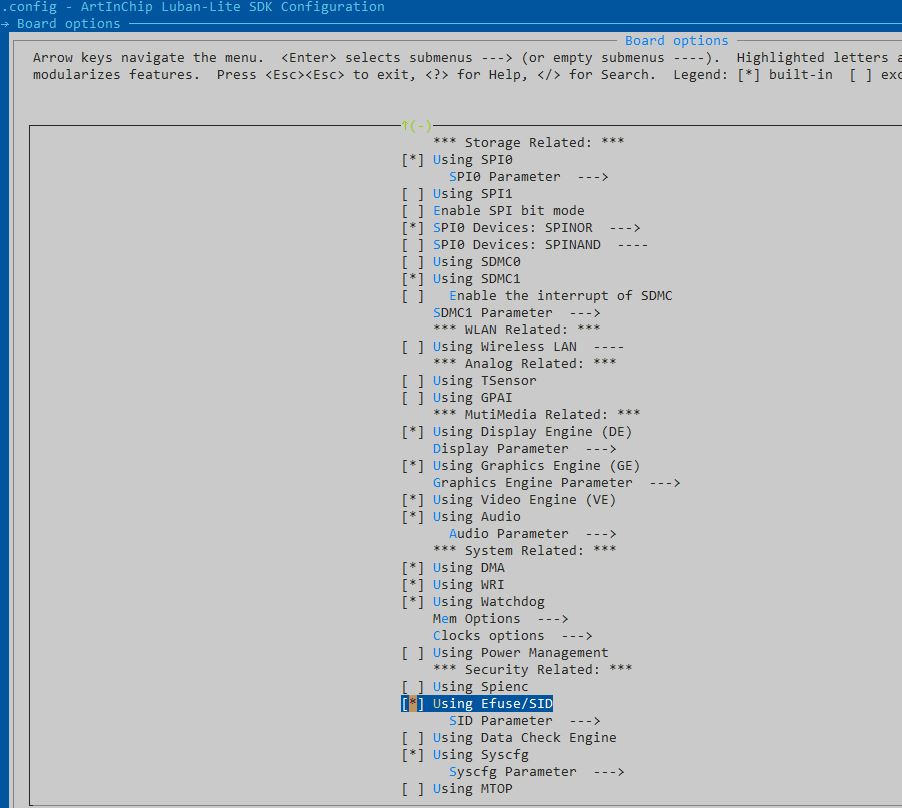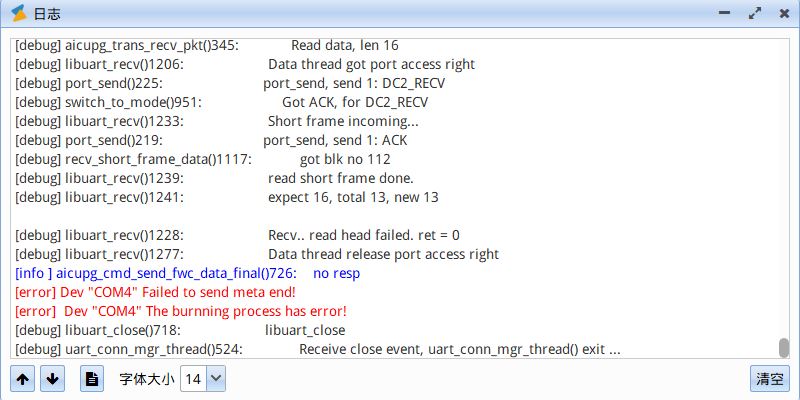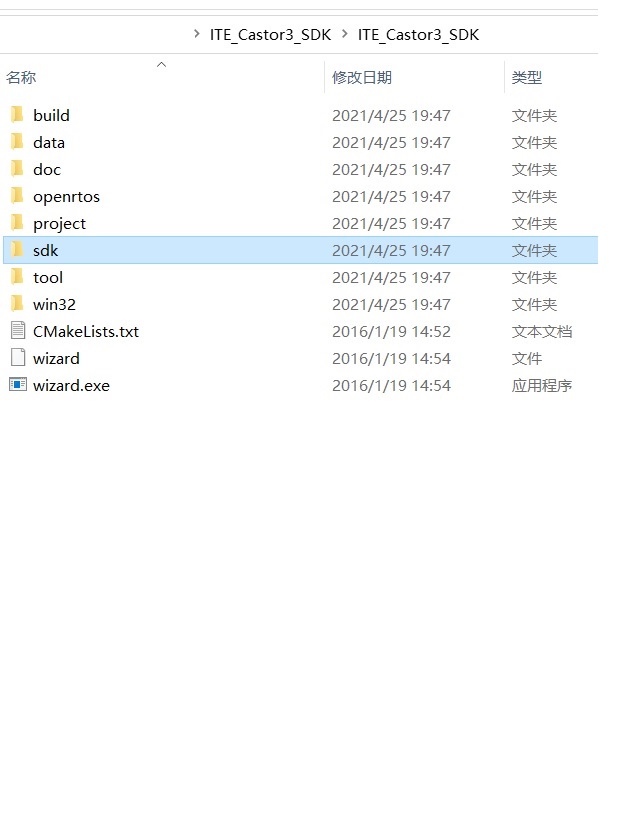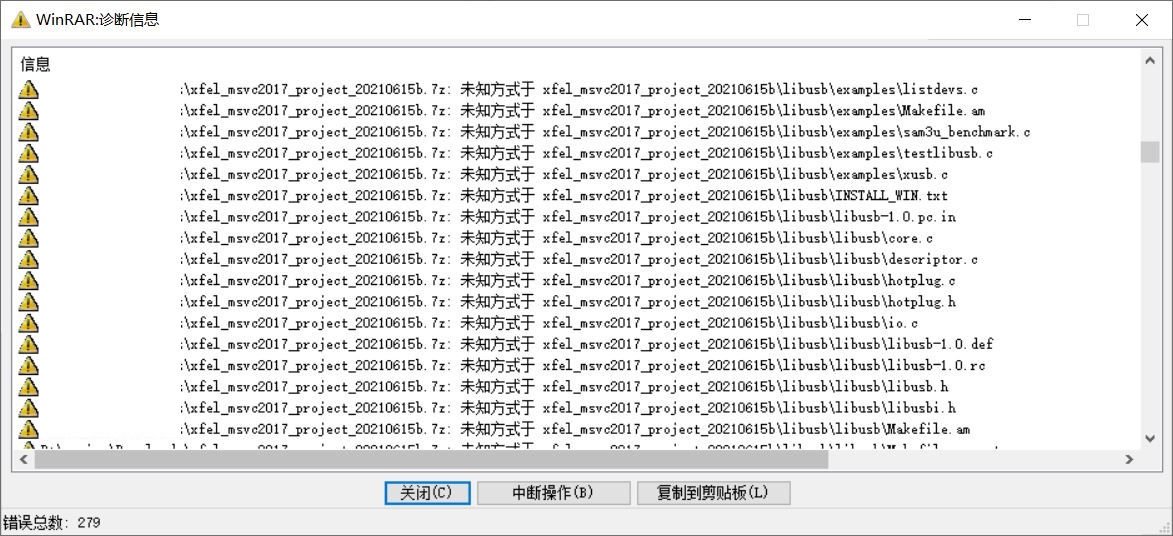- 首页
- » 搜索
- » novice 发表的帖子
页次: 1
#1 Re: 工业芯 匠芯创 » D12X 的Luban-lite在VS code下默认是RT-Thread怎么切换到RTOS呢? » 2025-12-29 11:26:51
@ArtInChip
您好,谢谢您的回复。
我说一说我的看法,一般来说MCU开发主流应该会使用以下几种模式:
1)裸跑+芯片厂商HAL。
2)裸跑+用户私有驱动程序框架+芯片厂商HAL。
3)FreeRTOS(或其它RTOS)+芯片厂商HAL。
4)FreeRTOS(或其它RTOS)+用户私有驱动程序框架+芯片厂商HAL。
5)RT-Thread+RT-Thread驱动程序框架+芯片厂商HAL。
我们使用了模式2和模式4。我们有自己的应用程序框架,驱动程序框架,如果有一份好用的HAL就能轻松对接上了,比如华芯微特SWM34S的HAL库我就觉得很好用。
因为公司有历史代码资产要沿用下来,对于一直在卖的产品肯定是不愿意大改的,除非是开发新产品。
因为我们有自己的应用程序框架和驱动程序框架,所以RTT那一套东西对我们来说没有用,scons, menuconfig也没有用,反而很难对接上。但是如果不用你们的构建系统又无法自动生成AIC影像文件和IMG烧录文件,所以我只好研究你们的资料自己搞了一个烧录工具,这样才可以脱离你们的构建系统。
如果你们提供一个独立的图形化AIC文件打包工具和图形化IMG文件打包工具,对那些不想用scons的用户或者是不能跟你们的BSP对接上的用户是很友好的。
#4 Re: 工业芯 匠芯创 » D12X 的Luban-lite在VS code下默认是RT-Thread怎么切换到RTOS呢? » 2025-12-25 10:00:57
我也觉得匠心创的BSP不好用。
作为芯片厂商应该以最简单的方式向用户呈现芯片的全部功能,所以把HAL库做好是最基本的要求。
如果厂商开发人员确实喜欢RT-THREAD,那可以把对RTT的支持做成可选包,但不应该硬植入。
不是所有人都用RTT的,芯片厂商不应该强迫用户使用一种RTOS,而是哪种RTOS热门就支持哪种。
芯片厂商也不应该界入用户的APP开发中,因为站在用户的角度看,肯定是不希望被一家芯片厂商绑死的。
如果确实要提供一站式APP开发支持,那也应该以可选包的形式提供,而不是在主线BSP里硬植入。
芯片方案的接口很复杂,比如类似YMODEM的更新协议,专用的AIC文件,专用的IMG文件等,但官方的上位机配套工具又显得很简陋,最基本的把固件放到RAM中运行的功能都不支持,每次都要固化到FLASH中才能跑,开发效率非常低。
#8 Re: 工业芯 匠芯创 » 匠心创原厂看过来:请问有没有BROM的接口资料? » 2025-09-15 09:58:53
#9 Re: 工业芯 匠芯创 » 匠心创原厂看过来:请问有没有BROM的接口资料? » 2025-09-13 08:19:49
#10 Re: 工业芯 匠芯创 » 匠心创原厂看过来:请问有没有BROM的接口资料? » 2025-09-12 14:12:55
#11 Re: 工业芯 匠芯创 » 匠心创原厂看过来:请问有没有BROM的接口资料? » 2025-09-12 14:09:12
#17 Re: 计算机图形/GUI/RTOS/FileSystem/OpenGL/DirectX/SDL2 » LVGL8.3.0 长文本滚动显示,设备连续运行几天之后不滚动! » 2023-11-10 18:19:52
#18 Re: 全志 SOC » F1C100S裸机启动慢 » 2023-09-22 16:25:49
#19 Re: 华芯微特 » 基于华芯SWM341+PhoenixUI的屏幕 » 2023-09-14 20:58:38
#20 Re: 华芯微特 » 基于华芯SWM341+PhoenixUI的屏幕 » 2023-09-06 14:35:10
#22 Re: 计算机图形/GUI/RTOS/FileSystem/OpenGL/DirectX/SDL2 » 请教:新唐的NUC970系列好兆易GD32H7系列做HMI开发组太屏,哪个更合适 » 2023-08-19 14:56:23
#24 Re: 全志 SOC » CoreMark Benchmark » 2023-06-15 12:40:17
#27 Re: 全志 SOC » 全志R128来袭,有想入坑的吗?我先来点初步研究成果 » 2023-05-23 12:32:34
#29 Re: 全志 SOC » freertos 运行是否需要使能mmu? » 2023-02-11 21:04:05
#30 Re: ESP32/ESP8266 » 乐鑫要发的新芯片esp32-P4 » 2023-01-10 13:54:59
#31 Re: 全志 SOC » F1C100S + FreeRTOS + USB Host » 2023-01-10 13:52:27
#32 Re: 上海航芯 » ACM32H5新产品需求及意见收集 » 2022-12-16 16:44:36
#33 Re: 计算机图形/GUI/RTOS/FileSystem/OpenGL/DirectX/SDL2 » KEIL开发LVGL显示汉字不能正常显示 » 2022-11-18 07:33:05
在UNICODE文本流前面加BOM是符合UNICODE标准的,为什么符合标准仍然会被一些人指责呢?指责方无非是为了己方利益而已,说白了就是争夺话语权(加BOM还是不加BOM的事实话语权)。
从技术上看加BOM能够指示读取程序快速解码,有利于提高用户体验,用户更喜欢。不加BOM也无大碍,无非是解码时需要逐个尝试UTF8/UTF16-LE/UTF16-BE/ANSI CODEPAGE等编码方式,耗费的时间多一点而已,从这一点看加BOM是比较聪明的做法(懒的人一般更聪明😝)。
我们知道XML文件有“encoding”,HTML文件有“charset”指示符,说明了客观上是有指示读取程序如何解码的需求,在UNICODE文本流前面加入BOM是能够给与一般文本文件读取程序一定的帮助又符合UNICODE标准的做法。
不管哪个系统的文本文件读取软件都应该能够识别开头的BOM,可以不加BOM但不应该不能识别BOM,这是为了提高用户体验而不是为了程序员自身的固执偏见
#34 Re: 计算机图形/GUI/RTOS/FileSystem/OpenGL/DirectX/SDL2 » KEIL开发LVGL显示汉字不能正常显示 » 2022-11-17 17:57:52
BOM不仅用来指示大小端还用来指示文本编码。开发过文本编辑器的都有体会,如果文本文件的开头没有BOM那么就只能靠猜,当然UTF8编码总是能够猜对的,因为它有自编码规则,但是ANSI CODEPAGE和UTF16就不是那么好猜了。编辑器每次都靠从头猜到尾来判断文本编码对效率来说也不好,假如编译器每打开一个源文件就要猜一次,那编译一个大工程也是够累的,当然有些编译器不愿意去猜,只承认ANSI编码。
顺便提一下,KEIL这个IDE以前是支持BOM的,到了5.x后好像取消了对BOM的支持,这样一来用户就变得不方便了。其实检测文件头的BOM只不过是几行代码的事情,我实在想不明白为什么他们不愿意支持这个功能。Win平台上的文本编辑工具绝大多数会支持BOM,连最简单的记事本都能够支持BOM,这才是以用户为中心的做法。
#37 Re: 全志 SOC » t113跑lvgl帧率 » 2022-10-27 17:29:39
#38 Re: 全志 SOC » t113跑lvgl帧率 » 2022-10-27 10:55:55
#39 Re: 全志 SOC » t113跑lvgl帧率 » 2022-10-26 23:40:21
如果T113跑AWTK的帧率达不到60fps,有可能是我之前就已经反馈的 `awtk-linux-fb`源码上的强制等待垂直同步信号导致的:
https://github.com/zlgopen/awtk-linux-fb/issues/88
双缓冲仍然要等待垂直刷新同步的,只是GUI渲染好一帧以后不应该呆呆的等待垂直刷新中断的到来,应该把渲染好的FB放入队列,在垂直刷新中断里面更换屏幕FB地址。
#41 Re: 计算机图形/GUI/RTOS/FileSystem/OpenGL/DirectX/SDL2 » lvgl从模拟器移植到F1C100S上,卡到怀疑人生? » 2022-05-01 17:37:46
#42 Re: 全志 SOC » 发现一个有意思的东西,4.3寸触摸屏,用的F1C200S » 2022-04-29 18:37:17
#43 Re: 全志 SOC » 哪位兄弟用过f133移植rtthread 能否提供一下, » 2022-03-28 14:51:39
首先说几句题外话,linux内核经过行业测试没错,但是也不能排除设备驱动程序写得蹩脚,宏内核的linux系统一样会崩掉。常用的RTOS获得各种安全认证,比如国产的RTT就获得了ISO 26262 ASIL D、IEC 61508 SIL 3、EN 50128 SIL 4几项安全认证,已经发射上天了。
回到正题,我明白你的意思是MMU可以隔离进程,即使进程崩掉也不会导致系统宕机。这个其实只是理想情况,质量差劲的APP也会吞噬系统资源,让系统处于不死也不活的状态。对于APP崩溃了不影响系统安全的说法,那我还可以说RTOS养条狗还可以无限复活呢。
系统的稳定性跟很多因素有关,很难简单去辩证,复杂的系统也可以很稳定,简单的系统也可能很差劲。
但是从工程管理的角度看,RTOS因为具有代码规模比较小的优势,可控性更强,代码质量更容易管理,所以RTOS的可靠性一般更高。
#44 Re: 全志 SOC » 哪位兄弟用过f133移植rtthread 能否提供一下, » 2022-03-27 19:57:51
#45 Re: Nuvoton N32905/N32926/NUC972/N9H20/N9H26/N9H30 » 新唐的N32926硬解码用800X480屏播800X480视频都很吃力,硬解了......是写fb的原因吗? » 2022-01-20 16:02:22
#46 Re: Nuvoton N32905/N32926/NUC972/N9H20/N9H26/N9H30 » 新唐的N32926硬解码用800X480屏播800X480视频都很吃力,硬解了......是写fb的原因吗? » 2022-01-20 15:55:30
#47 Re: 计算机图形/GUI/RTOS/FileSystem/OpenGL/DirectX/SDL2 » lvgl7重复调用lv_img_set_src后造成系统(RTOS)死机 » 2021-12-28 14:14:13
#48 Re: 技术人生/软件使用技巧/破解经验/技术吐槽/灌水 » 盗版CH340的被判刑了 » 2021-12-21 14:54:24
#49 Re: 全志 SOC » f1c100s性能和stm32哪个型号性能差不多啊 » 2021-12-15 19:22:50
#50 Re: 全志 SOC » 兄弟们,MangoPi-麻雀MQ已成功量产 » 2021-12-10 16:28:48
#51 Re: 全志 SOC » 开源一个6000行的2D矢量图形库libcg,零依赖,API接口类似cairo,在某些场景可以代替cairo,特别适合裸奔场景。 » 2021-12-04 12:29:57
#52 Re: 全志 SOC » 开源一个6000行的2D矢量图形库libcg,零依赖,API接口类似cairo,在某些场景可以代替cairo,特别适合裸奔场景。 » 2021-12-03 17:00:22
今日特意测试了一下这份代码,把它移植到了VC++上面跑了一下。
代码大致没有什么问题,但是建议考虑一下不同编译器之间的兼容性。
移植到VC上时为了方便把库代码改成了CPP后缀,并且改动了一些地方。
1、改成CPP是因为函数内变量声明位置比较随意,标准C不通过。
2、cg_array_ensure由宏改成了模板函数,因为VC++里面malloc需要强制转换。
3、min/max宏改了。
4、SW_FT_MSB用VC++的intrinsic改写了。
5、库代码当中所有malloc的地方加了强制类型转换。

#53 Re: 全志 SOC » 开源一个6000行的2D矢量图形库libcg,零依赖,API接口类似cairo,在某些场景可以代替cairo,特别适合裸奔场景。 » 2021-12-03 12:25:06
#54 Re: PikaPython(嵌入式Python引擎) » 【pikascript】超轻量级的跨平台嵌入式Python解释器,可以在STM32G030等小资源MCU运行 » 2021-12-02 21:12:15
#55 Re: 全志 SOC » 【全开源/D1s】芒果派麻雀 MangoPi-MQ1 基于D1s 的 RISC-V Linux小板 【最新消息:淘宝开卖了,链接在一楼】 » 2021-12-02 13:55:35
#57 Re: Nuvoton N32905/N32926/NUC972/N9H20/N9H26/N9H30 » 请教关于NUC972开发项目需求,麻烦大佬给个评估和可行性 » 2021-11-29 19:26:45
#58 Re: 全志 SOC » 哪吒D1运行lvgl8在24寸1080P显示器上渲染 » 2021-11-04 12:49:17
@novice
具体哪方面不够看呢?
我手中的这份LVGL是8.1版本,这是它的硬件抽象层,可以看到它并没有对硬件加速很感兴趣,主要还是依赖软件来执行。
真正专业的HAL应该能够利用硬件矩形填充(包括阿尔法填充)、硬件BLT操作(包括blend),硬件像素格式转换(RGB565/ARGB888/YUV422等)、硬件2x2矩阵操作(旋转、缩放、平移、剪切等)、硬件光标等。如果硬件不支持那就用软件完成。
但是这些东西可能会提高驱动移植的难度,而且也提高了对资源的需求,所以LVGL优先选择了小巧的方向。LVGL还有一些分散的代码利用STM32/NXP的硬件加速,不过很不规范,所以我猜想他们会继续改版。
LVGL不支持这些东西不是它的错,它的定位是小资源硬件平台。1080P这种高分辨率场合还是不要为难它了,毕竟MPU不仅仅要做GUI绘制还要处理其它事务,Fill/Blend/BitBlt这些繁重的任务最好还是硬件来完成。
/**
* Display Driver structure to be registered by HAL.
* Only its pointer will be saved in `lv_disp_t` so it should be declared as
* `static lv_disp_drv_t my_drv` or allocated dynamically.
*/
typedef struct _lv_disp_drv_t {
lv_coord_t hor_res; /**< Horizontal resolution.*/
lv_coord_t ver_res; /**< Vertical resolution.*/
/** Pointer to a buffer initialized with `lv_disp_draw_buf_init()`.
* LVGL will use this buffer(s) to draw the screens contents*/
lv_disp_draw_buf_t * draw_buf;
uint32_t full_refresh : 1; /**< 1: Always make the whole screen redrawn*/
uint32_t sw_rotate : 1; /**< 1: use software rotation (slower)*/
uint32_t antialiasing : 1; /**< 1: anti-aliasing is enabled on this display.*/
uint32_t rotated : 2; /**< 1: turn the display by 90 degree. @warning Does not update coordinates for you!*/
uint32_t screen_transp : 1; /**Handle if the screen doesn't have a solid (opa == LV_OPA_COVER) background.
* Use only if required because it's slower.*/
uint32_t dpi : 10; /** DPI (dot per inch) of the display. Default value is `LV_DPI_DEF`.*/
/** MANDATORY: Write the internal buffer (draw_buf) to the display. 'lv_disp_flush_ready()' has to be
* called when finished*/
void (*flush_cb)(struct _lv_disp_drv_t * disp_drv, const lv_area_t * area, lv_color_t * color_p);
/** OPTIONAL: Extend the invalidated areas to match with the display drivers requirements
* E.g. round `y` to, 8, 16 ..) on a monochrome display*/
void (*rounder_cb)(struct _lv_disp_drv_t * disp_drv, lv_area_t * area);
/** OPTIONAL: Set a pixel in a buffer according to the special requirements of the display
* Can be used for color format not supported in LittelvGL. E.g. 2 bit -> 4 gray scales
* @note Much slower then drawing with supported color formats.*/
void (*set_px_cb)(struct _lv_disp_drv_t * disp_drv, uint8_t * buf, lv_coord_t buf_w, lv_coord_t x, lv_coord_t y,
lv_color_t color, lv_opa_t opa);
/** OPTIONAL: Called after every refresh cycle to tell the rendering and flushing time + the
* number of flushed pixels*/
void (*monitor_cb)(struct _lv_disp_drv_t * disp_drv, uint32_t time, uint32_t px);
/** OPTIONAL: Called periodically while lvgl waits for operation to be completed.
* For example flushing or GPU
* User can execute very simple tasks here or yield the task*/
void (*wait_cb)(struct _lv_disp_drv_t * disp_drv);
/** OPTIONAL: Called when lvgl needs any CPU cache that affects rendering to be cleaned*/
void (*clean_dcache_cb)(struct _lv_disp_drv_t * disp_drv);
/** OPTIONAL: called to wait while the gpu is working*/
void (*gpu_wait_cb)(struct _lv_disp_drv_t * disp_drv);
/** OPTIONAL: called when driver parameters are updated */
void (*drv_update_cb)(struct _lv_disp_drv_t * disp_drv);
/** OPTIONAL: Fill a memory with a color (GPU only)*/
void (*gpu_fill_cb)(struct _lv_disp_drv_t * disp_drv, lv_color_t * dest_buf, lv_coord_t dest_width,
const lv_area_t * fill_area, lv_color_t color);
/** On CHROMA_KEYED images this color will be transparent.
* `LV_COLOR_CHROMA_KEY` by default. (lv_conf.h)*/
lv_color_t color_chroma_key;
#if LV_USE_USER_DATA
void * user_data; /**< Custom display driver user data*/
#endif
} lv_disp_drv_t;#59 Re: 全志 SOC » 【全开源/D1s】芒果派麻雀 MangoPi-MQ1 基于D1s 的 RISC-V Linux小板 【最新消息:淘宝开卖了,链接在一楼】 » 2021-10-28 12:30:30
#60 Re: 计算机图形/GUI/RTOS/FileSystem/OpenGL/DirectX/SDL2 » 自己做的样机,UI效果不错,实时系统openrtos » 2021-10-09 12:14:56
#62 Re: 全志 SOC » 哪吒D1运行lvgl8在24寸1080P显示器上渲染 » 2021-08-25 12:24:09
#63 Re: 计算机图形/GUI/RTOS/FileSystem/OpenGL/DirectX/SDL2 » LittleVGL eclipse 仿真安装教程 » 2021-08-12 17:03:09
#64 Re: Nuvoton N32905/N32926/NUC972/N9H20/N9H26/N9H30 » 请问一下NUC972上跑linux应用串口响应时间最短为时间为多少?? » 2021-07-19 20:33:45
#65 Re: 全志 SOC » 用 MSVC2017 编译 XFEL 项目 » 2021-06-17 14:52:43
novice 说:解压出错啊,楼主快赔钱!
https://whycan.com/files/members/1850/捕获.jpg用7z试一试?
解压 xfel_msvc2017_project_20210615b.7z 正常
晕哥能不能压成RAR发上来?ZIP更好啊?
#66 Re: 全志 SOC » 用 MSVC2017 编译 XFEL 项目 » 2021-06-17 14:00:19
#70 Re: 全志 SOC » 貌似 MDK 真的不能调 Cortex-A7 内核的 V3s » 2021-05-31 21:53:54
#73 Re: RISC-V » [juicevm] 只需要不到5000行代码实现一个risc-v虚拟机,纯c语言实现,无第三方库,支持ESP32 & GDB » 2021-05-08 18:24:27
bellard的riscv&x86模拟器
https://bellard.org/tinyemu/
下了,1M大小,支持X86和RISC-V,还可以json配置。不错,正在学习。
#76 Re: 计算机图形/GUI/RTOS/FileSystem/OpenGL/DirectX/SDL2 » N32926上移植FREERTOS+EMWIN,显示的图标有干扰条问题! » 2021-04-11 20:02:01
#77 Re: Qt/MSVC/MINGW/C++/MFC/GTK+/Delphi/BCB » 请问一个windows祖传项目,只要include winsock2.h就会出现 GetSystemTime / HANDLE 链接出错 » 2021-03-24 19:00:31
#80 Re: 全志 SOC » 尝试从零开始开发全志F1C100S » 2021-03-12 16:43:41
#81 Re: 全志 SOC » 发一分全志 视频解码库 API 手册。 » 2021-03-11 20:19:12
#83 Re: RISC-V » [juicevm] 只需要不到5000行代码实现一个risc-v虚拟机,纯c语言实现,无第三方库,支持ESP32 & GDB » 2021-03-07 15:14:19
#87 Re: 全志 SOC » 为什么Cache 写通模式 V3S还跑不过F1C100 » 2021-02-23 00:23:06
#88 Re: 技术人生/软件使用技巧/破解经验/技术吐槽/灌水 » 使用C++解释器动态调试你的嵌入式C程序:cling the C++ interpreter on ARM » 2021-02-18 18:33:02
#89 Re: 计算机图形/GUI/RTOS/FileSystem/OpenGL/DirectX/SDL2 » NXP出了个LVGL界面设计器 ---- Gui-Guider-Setup-1.0.0-GA.exe » 2021-02-03 20:48:34
#90 Re: DIY/综合/Arduino/写字机/3D打印机/智能小车/平衡车/四轴飞行/MQTT/物联网 » ZLG发布了一个资源超级丰富的吗ARM9 ZMP110 芯片,不知道价格如何,发在公众号的文章随后删了,不知道啥意思 » 2021-01-28 15:01:03
#91 Re: 哇酷地摊(跳蚤市场) » 迪卡的闲鱼店,各种好货 » 2021-01-10 19:49:00
#93 Re: Nuvoton N32905/N32926/NUC972/N9H20/N9H26/N9H30 » N32926裸机,fatfs文件系统f_mount()挂载失败问题 » 2020-06-20 10:07:57
#94 Re: Qt/MSVC/MINGW/C++/MFC/GTK+/Delphi/BCB » 求教,800*480的电阻触控屏,qt5程序大小设为800*480后,按键就失控。 » 2020-06-05 17:08:57
#95 Re: Nuvoton N32905/N32926/NUC972/N9H20/N9H26/N9H30 » 请教各位大佬:Shadow Space for SDRAM是什么意思?谢谢! » 2020-05-18 08:33:54
#98 Re: Nuvoton N32905/N32926/NUC972/N9H20/N9H26/N9H30 » 能分享一下N9H26有关文件系统的资料吗?谢谢! » 2020-05-07 15:37:56
文档来了。
不过新唐的裸机SDK代码很烂的,NVTFAT没有源代码而且还跟Nand Flash/SPI Flash/SD等驱动耦合得很严重,总之就是烂。
#99 Re: 全志 SOC » 商业使用F1C003芯片大概需要多少钱? » 2020-04-30 08:55:52
#100 Re: 计算机图形/GUI/RTOS/FileSystem/OpenGL/DirectX/SDL2 » [原创开源]emwin导航界面支持Awesome图标字体 » 2020-04-28 11:35:48
#101 Re: SigmaStar/SSD201/SSD202/SSD212 » 有一个对标F1C800的芯片SigmaStar SSD201有谁了解吗 双核A7 » 2020-04-24 08:53:12
#102 Re: 技术人生/软件使用技巧/破解经验/技术吐槽/灌水 » MiniGui使用,每隔一秒在静态框中显示系统时间,有时会闪一下,有大佬看看代码哪有问题吗,官方的例子 » 2020-04-22 09:00:00
#106 Re: 计算机图形/GUI/RTOS/FileSystem/OpenGL/DirectX/SDL2 » 各位大牛,Nuvoton N9H26 emWin卡在GUI_Init()里了,我该怎样排查问题?谢谢! » 2020-03-27 09:45:15
#108 Re: Nuvoton N32905/N32926/NUC972/N9H20/N9H26/N9H30 » 新唐的N32926硬解码用800X480屏播800X480视频都很吃力,硬解了......是写fb的原因吗? » 2020-03-16 08:33:21
#109 Re: 华芯微特 » 新鲜出炉,SWM320-128pin的芯片样品以及DEMO版已经上市 » 2020-03-11 14:36:33
#110 Re: 全志 SOC » LittlevGL卡死 » 2020-02-25 22:03:02
#111 Re: 全志 SOC » F1C200S入坑手记 » 2020-02-24 14:21:20
#114 Re: 华芯微特 » 【华芯微特-SWM320VET7人机交互TFT屏方案手册】 » 2020-01-03 17:32:25
#115 Re: Php/Nodejs/Web/HTML5/Javascript/微信开发/Python » 为什么 163.com 和 qq.com 的官网字符编码都改成了 gbk/gb2312 了呢? » 2020-01-03 17:29:51
#116 Re: 全志 SOC » F1C100S做的串口屏硬件图纸分享,有需要的可以联系,坛友优惠价 » 2019-12-31 00:02:16
#117 Re: Nuvoton N32905/N32926/NUC972/N9H20/N9H26/N9H30 » N9H26支持ARGB_8888格式的图片显示吗? » 2019-10-15 23:57:17
#118 Re: RISC-V » 兆易创新发布RISC-V单片机,GD32VF103系列。 » 2019-08-25 11:13:18
#119 Re: Nuvoton N32905/N32926/NUC972/N9H20/N9H26/N9H30 » 自己画的NUC972开发板原理图,请各位大佬多多指教。 » 2019-08-17 20:39:02
#120 Re: 全志 SOC » xboot 的 GNU C 内嵌汇编 改为 MDK 风格 » 2019-08-06 08:34:21
页次: 1
- 首页
- » 搜索
- » novice 发表的帖子
太原小智科技有限责任公司 - 东莞哇酷科技有限公司联合开发
